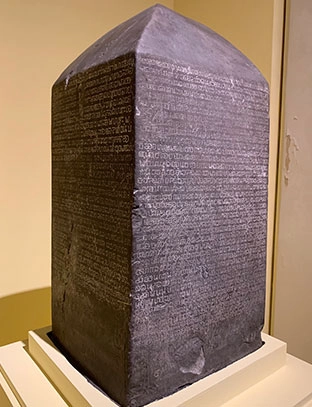Do you know the history of the language of the country of smiles? Who created our alphabet? Today you will learn everything about our language, with more than 25 million speakers, because we answer your most frequently asked questions!
How did Thai come about?
Learning Thai is easier and more interesting if you know its origin: Siamese belongs to the Kra-Dai language family. This language family is presumed to have its roots in what we know today as southern China. Some linguistic experts have raised possible connections with Austro-Asiatic families. As populations moved south and southeast, these languages diversified, eventually giving rise to Thai.

The story of King Ramkamhaeng of Thailand is inspiring and helps us understand the role of the Thai alphabet to the development of the country: Ramkamhaeng, also known as Ramkamheng, was an influential Thai monarch who ruled during the Sukhothai period in the 13th century.
Ramkamhaeng was born around 1237 and became the third king of the Kingdom of Sukhothai in 1279, succeeding his father, King Si Inthrathit. During his reign, which lasted until his death in 1298, Ramkamhaeng carried out significant reforms in his kingdom and left a lasting legacy in Thai history, such as the creation of the Thai alphabet. Although it cannot be stated with certainty that he invented it from scratch, he is credited with adapting an existing writing system to the Thai language. The Thai alphabet was based on the Khmer alphabet, which in turn had influences from Sanskrit. Ramkamhaeng modified this system to better fit the phonology of Thai and to effectively express the sounds of his native language.

Ramkamhaeng’s most famous contribution to Thai writing is the famous “Ram Khamhaeng Inscription,” a stone inscription found in Sukhothai dating back to the year 1292. This ancient document is considered one of the earliest examples of Thai writing and is a valuable testimony of the country’s early history. The inscription reveals aspects of Sukhothai society and administration in that period and is evidence of the importance that Ramkamhaeng attributed to writing and communication. This allowed for greater standardization and promotion of Thai as the language of administration and culture.

What is the Thai alphabet like?
The first step to learning Thai is to learn the Thai alphabet, known as “อักษรไทย” (Akson Thai) in Siamese, it is a writing system used to represent the Thai language.
Consonants
The Thai alphabet consists of 44 consonants. These consonants are grouped into three classes according to their type of articulation: low, medium and high.
- Low class (อักษรต่ำ – Akson Tam): contains 21 consonants and is characterized by having a low tone in the pronunciation.
- Middle class (อักษรกลาง – Akson Klang): also contains 21 consonants and has a middle tone in pronunciation.
- Upper class (อักษรสูง – Akson Sung): it is made up of 2 consonants and is pronounced with a high tone.
Vowels
Vowels are divided into short and long, and are represented by specific symbols that are placed above, below or around the consonants.
- Short vowels: There are 9 short vowels in Thai and they are represented by diacritics that modify the consonants.
- Long vowels: There are 9 long vowels in Thai, which are represented by special letters called “open syllables” or by doubling the letter of the short vowel.
Tone
Thai is a tonal language, meaning that the meaning of a word can change depending on the tone of the pronunciation. Thai has five different tones: high, middle, low, rising and falling. Tones are indicated in writing by specific markings, such as the “่” symbol for the low tone.

So is it easy to learn Thai?
Naturally, the ease of learning Thai depends on various factors, such as your native language, your previous experience with other languages, your motivation and your dedication. Thai presents many challenges as it is a tonal language and uses a completely different alphabet than Latin. Unlike other languages, such as English, it is not easy to access literature or cinema in our language from Spain. complicating things a little more. Personal motivation and perseverance are essential, and previous experience with non-Latin or tonal languages can provide advantages.
If you want to start learning Thai and be able to speak with us in the land of smiles, we share some tips and tricks with you:
- Learn the alphabet: Start by familiarizing yourself with the Thai alphabet (อักษรไทย – Akson Thai). This will help you read and write in Thai. Spend time practicing writing letters and syllables.
- Study the tones: Since Thai is a tonal language, pay special attention to the five different tones. Listening and repeating words and phrases with different tones will help you improve your pronunciation.
- Practice regularly: Consistency is key to learning a new language. Spend time each day studying and practicing Thai, even if it’s just for a few minutes.
- Cultural Immersion: If you have the chance, immerse yourself in Thai culture. Getting a Thai massage is a good way to exchange a few words in Siamese, but full immersion – traveling to Thailand or interacting with native speakers can speed up your learning and help you understand the cultural context in which the language is used. .
- Friends and study partners: If possible, find friends or study partners with whom you can practice Thai. Regular conversational practice is essential to improve fluency.
- Music and movies in Thai: Listening to Thai music and watching movies or series in Thai will help you familiarize yourself with the rhythm and sound of the language. Try to follow the lyrics of the songs to improve your listening comprehension.

Is there literature in Thai?
Of course! Thailand has a rich literary tradition spanning centuries and has produced high-quality literary works in various genres. Some notable examples include Sunthorn Phu’s “Phra Aphai Mani”, an epic recounting the adventures of a prince in mythical lands; “Four Reigns” by Kukrit Pramoj, a historical novel that offers a view of Thai history through four reigns; “The House of Spirit and Flesh” by Pramoj Kukrit, which explores spirituality and Thai culture; or “Si Phaendin” by Siburapha, a social satire criticizing corruption in the era of King Rama V These works represent the diversity and depth of Thai literature, reflecting the country’s culture, history and society.

Are other languages spoken in Thailand?
A number of regional Thai languages are spoken in Thailand in addition to Standard Thai: Although these languages are spoken by significant communities in Thailand, most speakers of dialects and minority languages also use Central Thai, which is the language of instruction in schools and universities throughout the country.
These are some of the languages that demonstrate the cultural richness of the country of smiles:
- Isan: Spoken in the Isan region, it is often considered similar to Lao due to its linguistic similarity. It was spoken by approximately 15 million people in 1983, and is written in the Thai alphabet.
- Nyaw: Mainly spoken in the provinces of Nakhon Phanom, Sakhon Nakhon and Udon Thani in northwestern Thailand.
- Galung: spoken in Nakhon Phanom province.
- Lü: spoken by around 78,000 people in northern Thailand.
- Northern Thai: spoken by approximately 6 million people in the ancient kingdom of Lanna, with Chiang Mai as one of the main areas.
- Phuan: spoken in Central Thailand and the Isan region.
- Phu Thai: spoken by around 156,000 people in Nakhon Phanom province.
- Shan: with approximately 56,000 speakers in northwest Thailand, along the border with the Shan State of Burma.
- Song: spoken by between 20,000-30,000 people in central and northern Thailand.
- Southern Thai: spoken by around 5 million people in 1990 in southern Thailand, including regions such as Pattani and Songkhla.
- Dam Thai: spoken by about 20,000 people in the Isan region and Saraburi province.
We hope that knowing better the history and characteristics of Siamese will encourage you to learn this language and discover Thailand.
Don’t forget that you can always enjoy the little Thailand of Barcelona at Thai Spa Massage and receive the Newsletters that we send monthly about this wonderful country!







